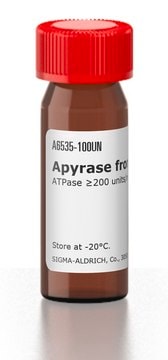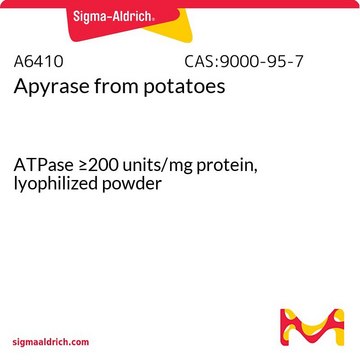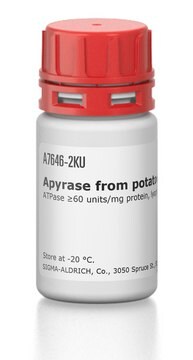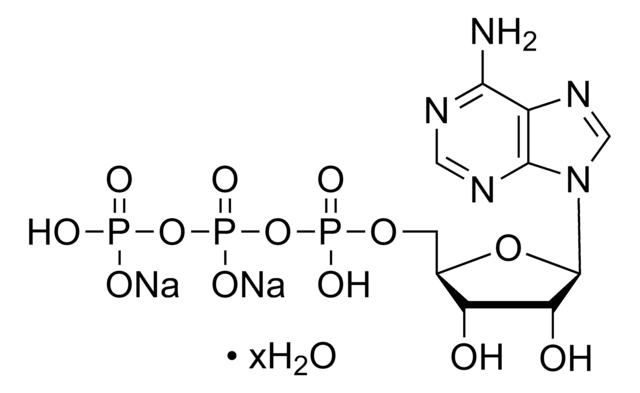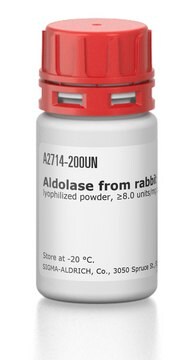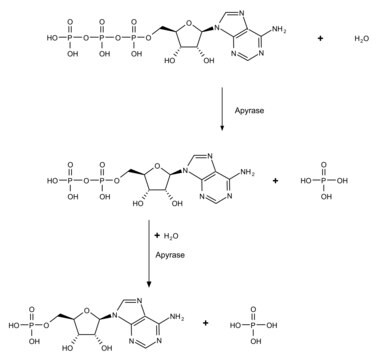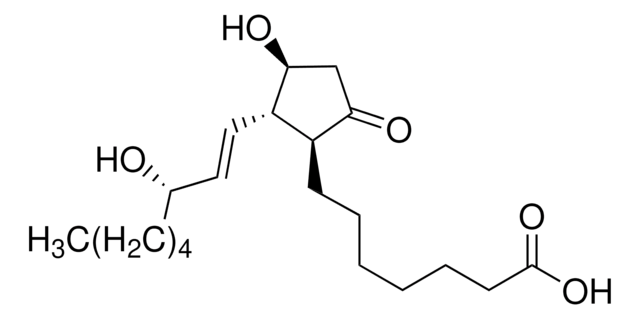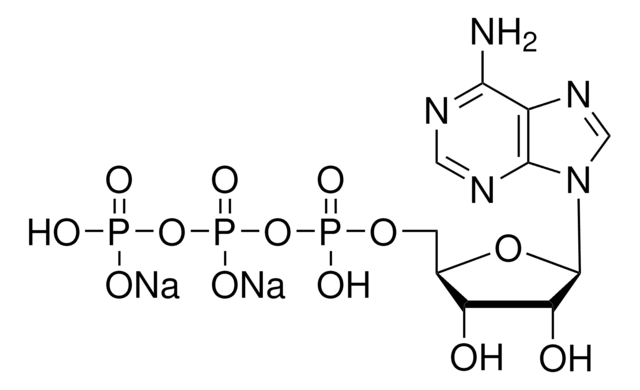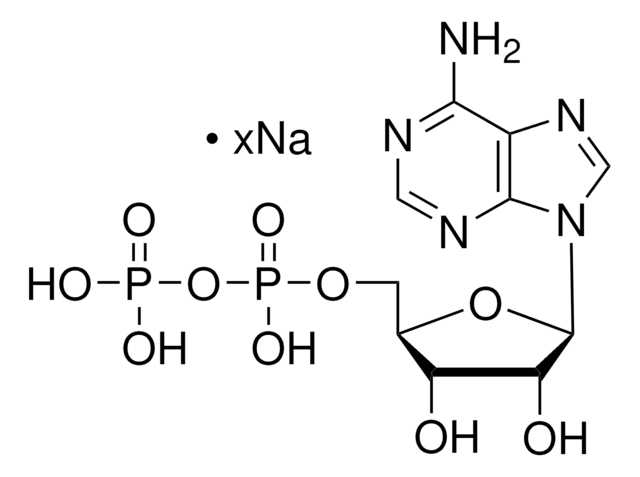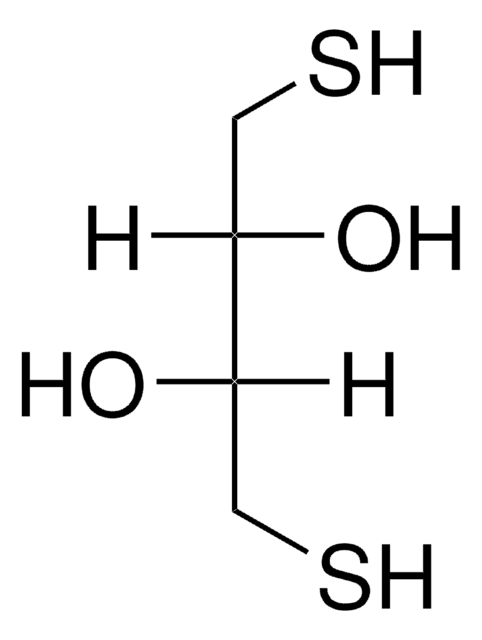A6132
Apyrase from potatoes
ATPase ≥3.0 units/mg protein, lyophilized powder
Synonyme(s) :
Adénosine 5′-diphosphatase, Adénosine 5′-triphosphatase
Se connecterpour consulter vos tarifs contractuels et ceux de votre entreprise/organisme
About This Item
Produits recommandés
Source biologique
potato
Niveau de qualité
Type
Grade I
Forme
lyophilized powder
ATPase activity
≥3.0 units/mg protein
Composition
Protein, 30-60%
Température de stockage
−20°C
Vous recherchez des produits similaires ? Visite Guide de comparaison des produits
Application
Au moins deux isoenzymes sont présentes dans diverses souches de S. tuberosum : l′une avec un rapport ATPase/ADPase élevé (∼ 10) et l′autre avec un rapport faible (∼ 1).
Réaction : ATP → ADP+Pi → AMP+2Pi.
Réaction : ATP → ADP+Pi → AMP+2Pi.
Apyrase is used to hydrolyze nucleoside triphosphates and diphosphates. Apyrase, from Sigma, has been used in inhibition studies of platelet-aggregation .
Actions biochimiques/physiologiques
Apyrase is found in all eukaryotes and some prokaryotes. Apyrase, from potato, has a crucial role in regulating growth and development. Apyrase is involved in the inactivation of synaptic ATP as a neurotransmitter following nerve stimulation and in the inhibition of ADP induced platelet aggregation to prevent thrombosis . Divalent metal ions are required for activity and best activity is observed with calcium ion at 5 mM.
Conditionnement
Sold on the basis of ATPase units.
Autres remarques
Mixture of high and low ratio isoenzymes.
Définition de l'unité
One unit will liberate 1.0 micromole of inorganic phosphorus per minute at pH 6.5 at 30 °C
Forme physique
Partially purified, lyophilized powder containing potassium succinate
Mention d'avertissement
Danger
Mentions de danger
Conseils de prudence
Classification des risques
Resp. Sens. 1
Code de la classe de stockage
11 - Combustible Solids
Classe de danger pour l'eau (WGK)
WGK 1
Point d'éclair (°F)
Not applicable
Point d'éclair (°C)
Not applicable
Équipement de protection individuelle
Eyeshields, Gloves, type N95 (US)
Faites votre choix parmi les versions les plus récentes :
Déjà en possession de ce produit ?
Retrouvez la documentation relative aux produits que vous avez récemment achetés dans la Bibliothèque de documents.
Les clients ont également consulté
Avanish Rai et al.
Bio-protocol, 11(1), e3874-e3874 (2021-03-19)
Isoprenoids represent the largest class of metabolites with amazing diversities in structure and function. They are involved in protecting plants against pathogens or herbivores or involved in attracting pollinators. Isoprenoids are derived from geranyl diphosphate (GPP; C10), farnesyl diphosphate (FPP;
V T Nachmias et al.
FEBS letters, 378(3), 258-262 (1996-01-15)
Capping of the barbed-ends of actin filaments is an important mechanism for control of the cytoskeleton. In platelets, a valuable model system, it has been thought that gelsolin was the major capping protein. We now report that platelets contain approximately
Mathieu F Chevalier et al.
Blood, 121(1), 29-37 (2012-10-09)
Natural regulatory T cells (Tregs) participate in responses to various chronic infections including HIV. HIV infection is associated with a progressive CD4 lymphopenia and defective HIV-specific CD8 responses known to play a key role in the control of viral replication.
Nicholas J Roberts et al.
Plant physiology, 161(1), 556-567 (2012-11-09)
Nodulation in legumes requires the recognition of rhizobially made Nod factors. Genetic studies have revealed that the perception of Nod factors involves LysM domain receptor-like kinases, while biochemical approaches have identified LECTIN NUCLEOTIDE PHOSPHOHYDROLASE (LNP) as a Nod factor-binding protein.
Tsan-Yu Chiu et al.
Plant & cell physiology, 53(11), 1913-1925 (2012-10-05)
Nucleoside triphosphate diphosphohydrolases (NTPDases; apyrases) (EC 3.6.1.5) hydrolyze di- and triphosphate nucleotides, but not monophosphate nucleotides. They are categorized as E-type ATPases, have a broad divalent cation (Mg(2+), Ca(2+)) requirement for activation and are insensitive to inhibitors of F-type, P-type
Notre équipe de scientifiques dispose d'une expérience dans tous les secteurs de la recherche, notamment en sciences de la vie, science des matériaux, synthèse chimique, chromatographie, analyse et dans de nombreux autres domaines..
Contacter notre Service technique